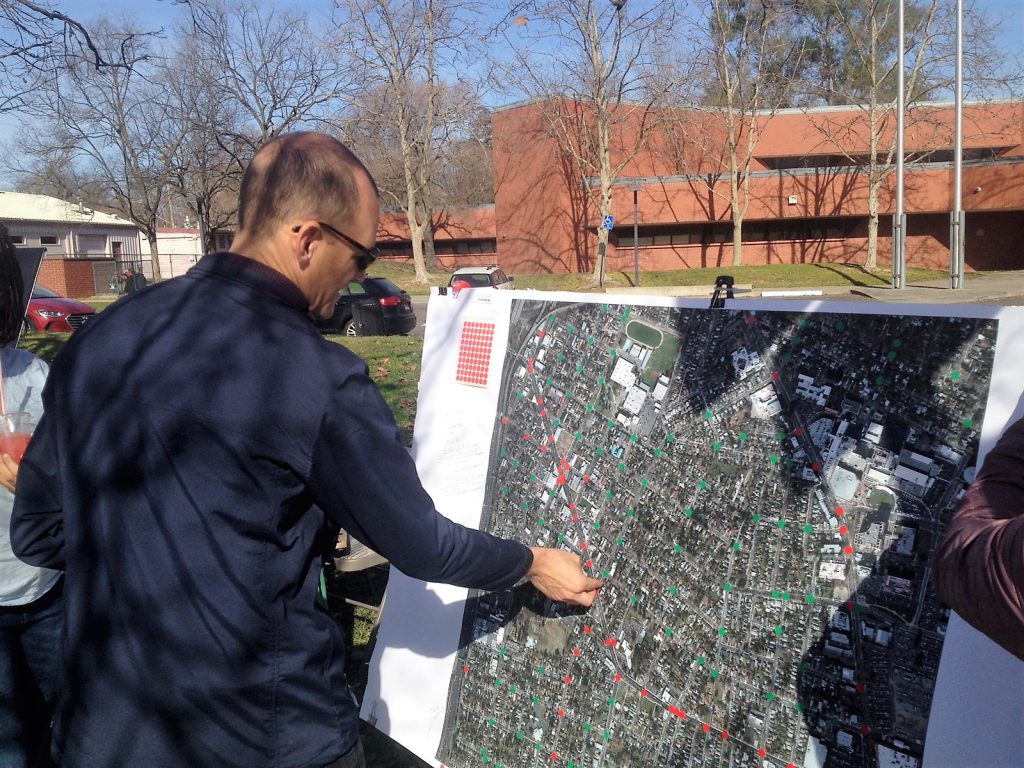As part of a community planning project across South Sacramento neighborhoods, WALKSacramento is piloting creative and genuine engagement activities to hear from as many residents as possible. This past Saturday, working with the Oak Park Neighborhood association, WALKSacramento set up a pop-up active transportation event where passersby shared stories, thoughts, and concerns about traffic safety in Oak Park. The insights provided last Saturday will help frame an upcoming walk audit being held in Oak Park on February 12 and inform the community’s forthcoming transportation plan.
When developing the pop-up, we had two main objectives:
1. Host a pop-up that invites natural conversation for neighbors to discuss traffic issues and solutions.
2. Provide a few different exercises for community members of all ages to engage in for a more holistic view of the issues.
Mapping Exercise
Some of the most important information to gather from community members are location specific concerns around walking and biking within their neighborhoods. For walk audits, we traditionally provide a map of the community and encourage participants to discuss areas specific to the walk audit route they want to call to attention. This mapping exercise tends to lend itself to great data like preferred walking or biking routes, actual and perceived barriers, historical changes in the community that impact transportation, and more granular information such as lighting, tree canopy, and even cracked sidewalks or cluttered bike lanes. Thus, it was a priority for us to expand this activity to our static engagement event. For the pop-up clinic, we asked participants to use color-coded stickers indicating concerns (red stickers) or areas where conditions are ideal (green stickers).Thanks to the great maps provided by SACOG, participants were able to jot down notes about their experiences, questions they had, and even solutions that they would advocate for. This information will be invaluable in selecting future walk audit routes and developing infrastructure recommendations.
Chalkboard Statements
Drawing inspiration from art installations popping up all over the world that provide a fun, yet effective way to gather community input, WALKSacramento built two chalkboards and asked participants to complete the following statements:
- A Healthy Oak Park Means…
- A Safe Oak Park Means…
While the mapping exercise was more literal and exact, the chalkboard exercise was imaginative and open-ended. It also gave participants walking by an opportunity to share how they would improve their community without feeling pressured to have a specific example on the map or be an expert on active transportation. Answers ranged from safer bike facilities to cleaning up trash on empty lots.
Photo Campaign
Last, we asked participants to finish the statement “Traffic Safety in Oak Park means to me…” and take a picture with their answer on the whiteboard. For WALKSacramento, it is important to put a face to the active transportation needs in a community. Those passing by were excited to give us feedback about their experiences and concerns regarding active transportation safety around the neighborhood. Some preferred to not do any of the activities and instead have a conversation about personal experiences and solutions while others were eager to do all three. We were honored to have Sacramento County Supervisor Phil Serna and Assembly Member Kevin McCarty stop by and discuss the project with OPNA and WALKSacramento, sharing what traffic safety means to them.
In total, we engaged about 20 people of different ages, backgrounds, and experiences in Oak Park. We gathered information about the importance of traffic calming on major arterials as well as on neighborhood streets, intersection improvements, and creating more visibility of pedestrians and cyclists. Community members also expressed interest in urban greening strategies, placemaking, and personal safety in particular. Our future efforts will be to refine the activities and increase participation.
A few things we learned:
- We loved the way the pop-up allowed people to interact at their own comfort level. Having multiple options made our data collection process more approachable.
- We got the word out! Doing a pop-up event is a great pre-walk audit event to hold to engage community members who would not normally attend a walk audit.
- When selecting the location of the pop-up, make sure it is a moderate – heavy foot trafficked area.
- To get the most interactions, set up in a location that already has a natural flow of foot traffic.
- Make sure you are setting up in a location where local residents gather. If a community has an area heavily visited by visitors – you will not necessarily get accurate feedback from the neighborhood that you interested in.
We are excited about the success of our first pop-up and are looking forward to incorporating pop-ups into future events.
